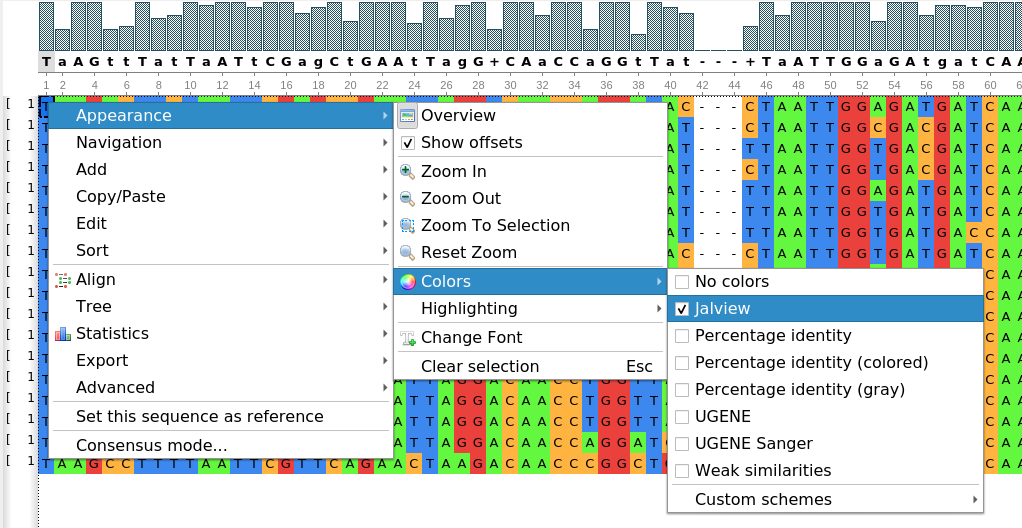It is possible to apply different coloring schemes for an alignment, so that nucleotide or amino acid residues are colored depending on some rules.
To set another coloring scheme, select the required item in the main (Actions → Appearance → Colors) or context menu (Appearance → Colors) of the Alignment Editor, or in the Color combo box on the Highlighting tab on the Options Panel.

Note that the coloring schemes setting may interfere with other alignment highlighting settings (see e.g. Highlighting combo box on the Highlighting tab of the Options Panel). Thus, the colors may vary in this case from the described below.
Coloring Schemes for Nucleotides
The following schemes options are available for a nucleotide alignment:
- No colors — do not color the residues background (i. e. all residues have a white background and black font).
- Jalview — use the following background colors: A - green, C - orange, G - red, T/U - blue. Gaps and characters of the extended nucleotide alphabet are not colored.
- Percentage identity — a residue background color depends on its presence in the column of the alignment: <=40% - white, 41-60% - light slate blue, 61-80% - medium slate blue, 81-100% dark slate blue.
- Percentage identity (colored) — colors depend on the residues percentage presence in a column. The following rules are applied (in the order of priority):
- If all residues (100%) are the same and there are no gaps, the residues in the column have a yellow background and red font.
- If there are 50% of one residue in the column and 50% of another (gaps are not taken into account), one-half of the residues has a green background and black font (the half to be colored is determined based on the following priorities: T>U>G>C>A>B>D>H>K>M>R>S>V>W>Y>N).
- If there is one or several residues in a column with a percentage number more or equal to the threshold parameter (see the Threshold parameter on the Highlighting tab of the Options Panel), then most frequent residues are colored as follows: light blue background color and blue font. Note that gaps are taken into account when calculating the percentage number in the column in this case. Also, if required, the same residues priorities are applied as in the previous rule.
- If the rules above are not applied for a residue, then it remains uncolored, i.e. white background color and black font are used.
- Percentage identity (gray) — this coloring scheme is similar to the Percentage identity scheme, but shades of gray color are used instead of the slate blue color.
- UGENE — this is the default coloring scheme, the following background colors are used: A - yellow, C - light green, G - light blue, T/U - light red, gap - white. Other colors may are used for characters of the extended nucleotide alphabet.
- UGENE Sanger — this coloring scheme is used in the UGENE Sanger Reads Editor, the background colors correspond to the peaks of Sanger chromatogram peaks: A - green, C - blue, G - light gray, T - red. The orange background color is used for a gap, the magenta background color is used for characters of the extended nucleotide alphabet.
- Weak Similarities — when there is a choice between two characters and it is not specified by other rules which character to color, following priorities: T>U>G>C>A>B>D>H>K>M>R>S>V>W>Y>N.
Coloring rules:
- Do not color gaps (“-“), i.e. use a black font and white background.
- Residues should be colored according to their percentage number in the column (use the priorities,
described above, in case of equal percentage numbers). - Residues with the most frequency/priority in the column.
- A custom scheme can be created and used with colors that depend on a residue.
Coloring Schemes for Amino Acids
The following schemes options are available for an amino acids alignment:
- No colors — do not color the residues background (i. e. all residues have a white background and black font).
- Buried index — depending on the frequency of occurrence inside a globule the amino acid residues are colored from light green (less frequent) to blue (most frequent).
- Clustal X — an emulation of the default color scheme in Clustal X, a graphical interface for the ClustalW multiple alignment programs.
- Helix propensity — depending on helix propensity the residues are colored from magenta (the highest helix propensity) to green (the lowest one).
- Hydrophobicity — residues are colored based on their hydrophobicity. Most hydrophobic residues are red, most hydrophilic are blue.
- Percentage identity — a residue background color depends on its presence in the column of the alignment: <=40% - white, 41-60% - light slate blue, 61-80% - medium slate blue, 81-100% dark slate blue.
- Percentage identity (gray) — this coloring scheme is similar to the Percentage identity scheme, but shades of gray color are used instead of the slate blue color.
- Strand propensity — residues with the highest strand propensity are yellow, with the lowest are blue.
- Tailor — see this publication by William R.Taylor.
- Turn propensity — residues with the highest turn propensity are red, with lowest are cyan.
- UGENE — this is the default coloring scheme, the following background colors are used for the residues: positive (KRH) - yellow, aromatic (FWY) - green, large alphatic hydrophobic (ILM) - blue, small hydrophobic (ST) - rose, GP - red, EX - gray.
- Zappo — amino acids residues are colored according to their physicochemical properties: alphatic/hydrophobic (residues ILVAM) - rose, aromatic (FWY) - orange, positive (KRH) - dark blue, negative (DE) - red, hydrophilic (STNQ) - light green, conformationally special (PG) - magenta, cysteine (C) - yellow.
- A custom scheme can be created and used with colors that depend on a character.